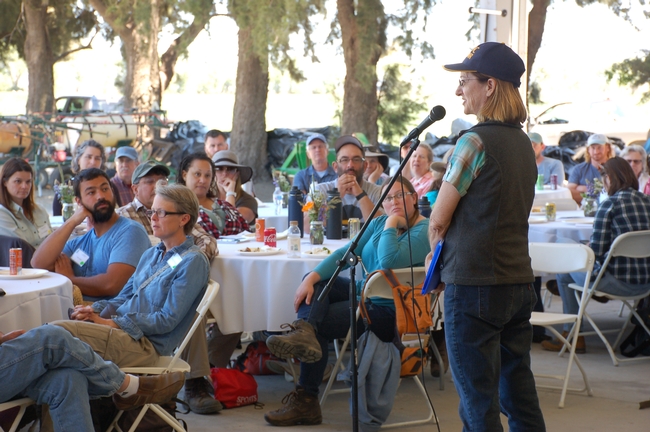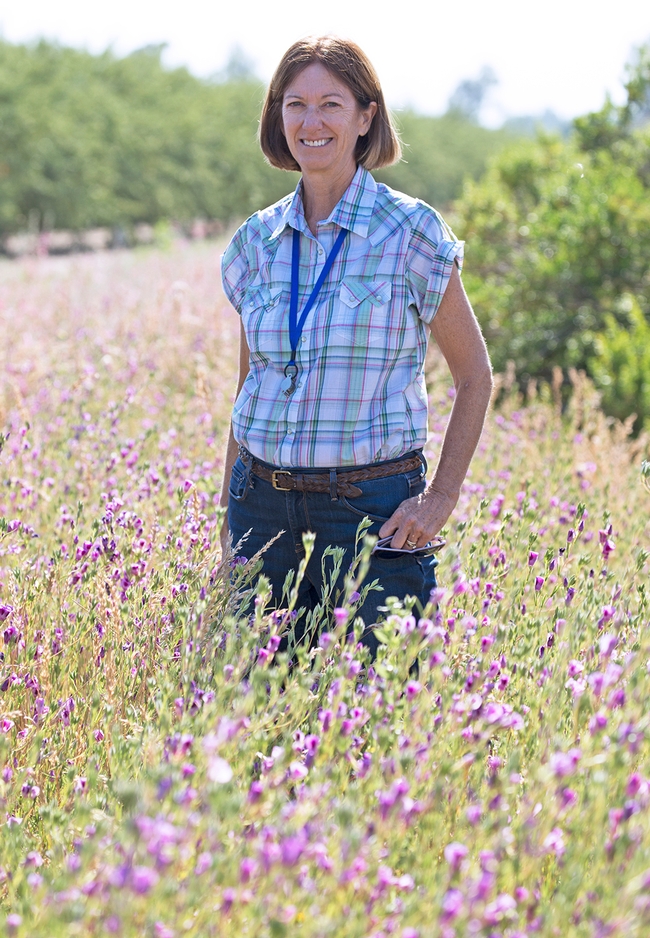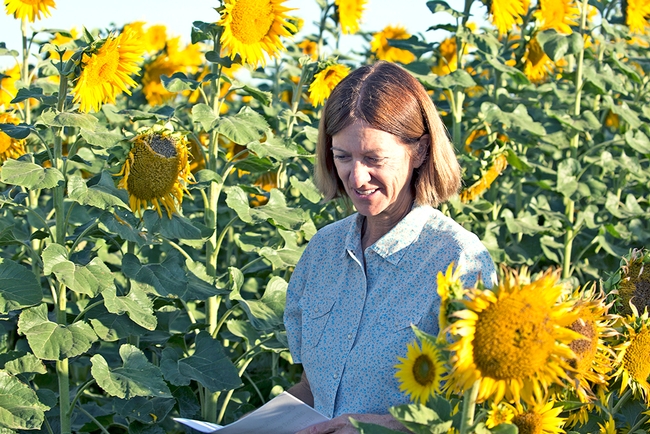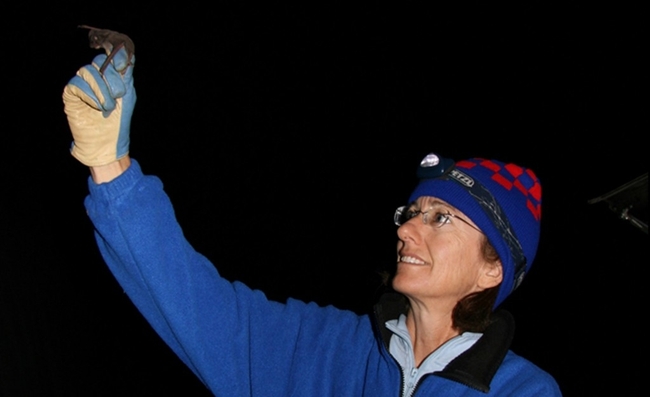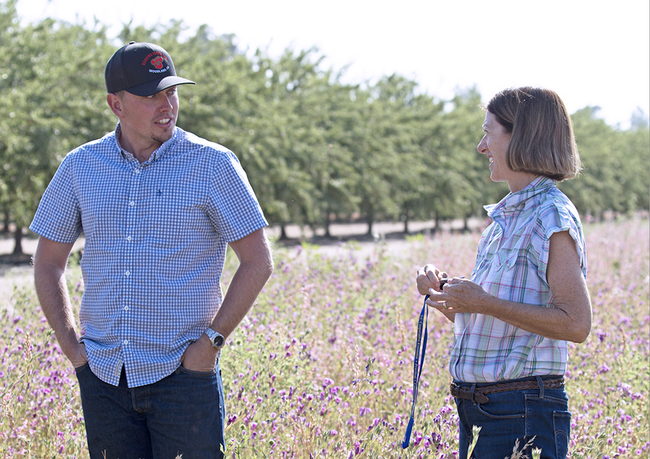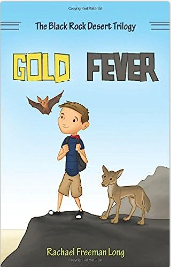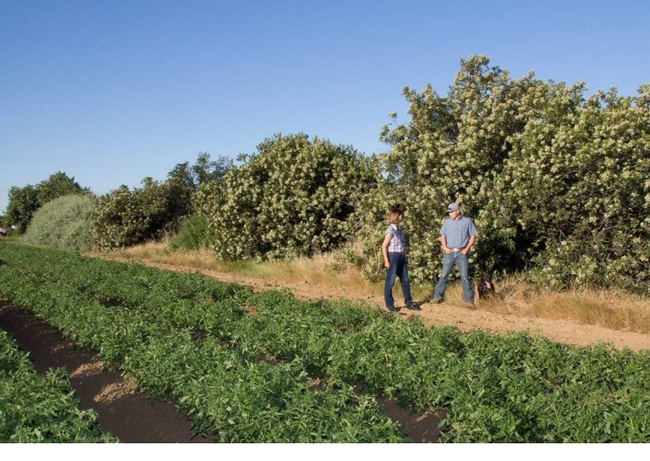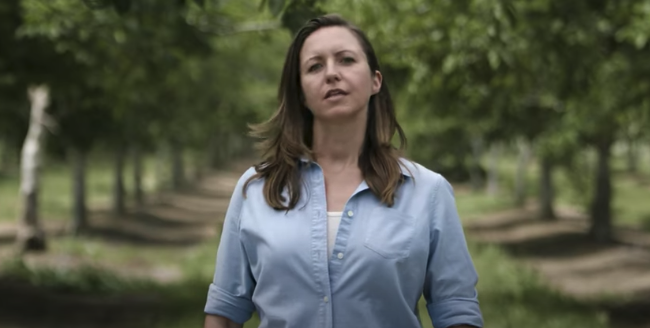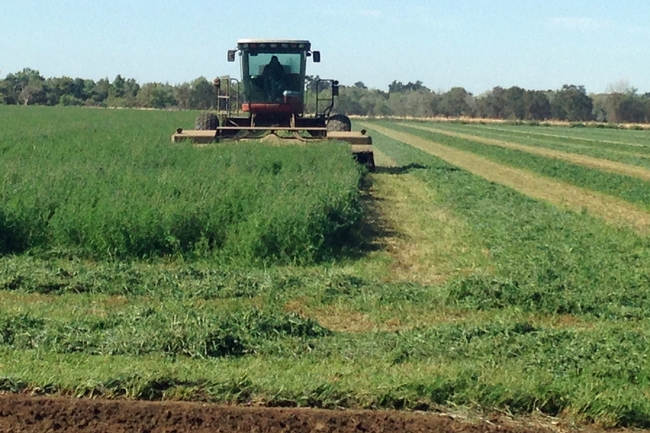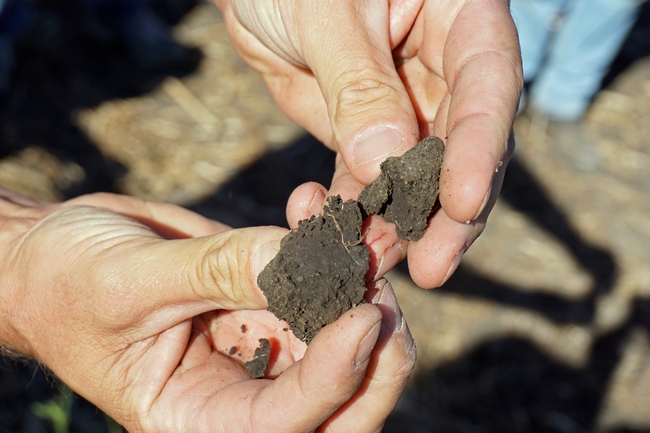Posts Tagged: Rachael Long
Rachael Long retires as UCCE farm advisor after 37 years
Long's research on crops, pollination and pest control guided farming practices in Yolo, Solano and Sacramento counties
Rachael Freeman Long grew up in Berkeley but was fascinated by farming. The UC Cooperative Extension farm advisor has spent the past 37 years doing research on crop production, pollination and pest control and collaborating with farmers.
Long worked with UCCE in Sonoma and San Joaquin counties as well as at UC Berkeley, before settling in Yolo County as a farm advisor in 1992. She has focused on field crops including alfalfa hay and other forages, dry beans, and hybrid seed crops such as sunflowers, melons and onions.
She plans to retire July 1 after serving growers in Yolo, Solano and Sacramento counties for 31 years.
Long's pest management studies highly influential
“Rachael has been a wonderful addition to our life in Yolo County, as well as to the whole farming community throughout the UCCE,” wrote walnut growers Dan and Sarah Hrdy. “Her enthusiasm and dedication to bees, birds and bats is wonderful.”
To produce practical research results, Long has collaborated on studies with the Hrdys and many other growers over the years. Her field studies informed the sunflower, alfalfa, onion seed and dry bean production manuals that she co-authored with UC ANR colleagues.
Cost-of-production reports on alfalfa, sunflowers, lima beans, common beans and garbanzo beans that she co-authored have been used by growers for obtaining farm loans. Since 2014, her cost studies have been used over 50,000 times.
Long's research and extension of integrated pest management practices have resulted in enhanced biodiversity, reduced pesticide use, higher crop yields, healthy soils and carbon sequestration, and greater farm productivity and profitability. Her research papers have been cited by scientists over 1,200 times. She was the recipient of the Bradford Rominger Agricultural Sustainability Leadership Award in 2019.
Adoption of new farming practices
Her work in the late 1990s documented how pesticides were transported offsite from farm fields in surface irrigation water. At the time, the agricultural industry was concerned the results would prompt increased regulations and restrictions on farming practices. But she persisted and her research led to the development and adoption of practices – such as pesticide choice and vegetative filter strips including cover crops – that are now commonly used to protect surface waters from pesticides used on farms.
“I'm proud of my community and appreciate the opportunity to work with farmers and the privilege of conducting research on farms,” Long said. “I'll forever be grateful to landowners for their support of my projects, even ones that seemed so far out there, like studying bats and pest control in walnut orchards!”
Her research has shown that bats, as well as insectivorous birds, help control insect pests on farms, which helps growers reduce their reliance on pesticides.
As scientists look for ways to slow climate change, one of Long's recent studies revealed that hedgerows sequester 36% more carbon than farmed areas.
“I loved working with students and postdocs on hedgerows,” she said. “We found that field edge plantings of native plants provide floral resources for natural enemies and bees that move into adjacent crops for enhanced pollination and pest control services in adjacent crops, reducing pesticide use and boosting yields. I'm proud that many have gone on to pursue careers in agriculture and natural resource conservation.”
Hedgerows become conservation practice
Mary Kimball, CEO of the Center for Land-Based Learning in Woodland, was Long's field assistant in 1996. Kimball, who worked for the Yolo Resource Conservation District, was the project manager for the first hedgerow project that Long led.
“Over the years, Rachael has strategically and methodically tackled every question, concern and potential barrier for on-farm hedgerow installation – not only disproving all of the myths about pests, but showing the dramatic importance of these native plant hedgerows to everything from wildlife habitat, insectary value, use by bird species, and most recently, carbon sequestration,” Kimball said.
“As a result, hedgerows are now by far the most applied-for conservation practice by farmers and landowners through USDA Natural Resources Conservation Service cost-sharing programs across the state,” Kimball added. “Her impact and the way that she went about doing this research – in collaboration and with all needs and concerns of the farmer in mind – show us how to tackle new ideas and ensure their sustainability over time.”
Lifelong interest in agriculture evolves with technology
The daughter of a UC Berkeley biology professor and graduate of UC Berkeley with a B.S. in biology and UC Davis with an M.S. in entomology, Long always had an interest in wildlife, conservation and exploring the natural world.
“I've always been interested in agriculture, probably from spending summers as a kid with family in Sonoma County,” she said. “However, what totally sparked my interest in crop production was hearing a farm advisor talk about integrated pest management when I was in college. I found that so inspiring that I changed my major from pre-med to agriculture, a great decision, not only for my career, but I met my husband through work and we currently live and farm here in the Woodland area.”
For a recent project addressing labor shortages, she developed research-based guidelines for growers to use spray drones to control pests in alfalfa hay production.
As a mother and a scientist, Long is committed to piquing children's interest in science. She has published three children's books chronicling a boy's adventures with wildlife, based on stories she told her own son, Eugene. Long recently published “See You Later Alligator,” an online children's book.
In retirement, Long is looking forward to having more time to write kids' books focusing on science literacy and “sharing more about how to respect and live with wildlife for everyone's safety – animals and people.”
“Next is a high adventure story that brings kids into a world of bees!” Long said. “I'm super excited with this ArcGIS storymap format to share online with kids! It's a great teaching opportunity maps, illustrations, and a storyline, along with discussion questions to engage kids!” Long and colleagues recently created a storymap on Native Bees.
Long, who received prestigious emeritus status from UC Agriculture and Natural Resources, will also finish up some research projects.
Daniel and Sarah Hrdy create endowment to fund UC Cooperative Extension research
The Yolo County walnut growers will provide as much as $100,000 per year for “practical” research
The University of California Division of Agriculture and Natural Resources (UC ANR) announced that Dan and Sarah Hrdy, owners of Citrona Farms LLC, a walnut farm in Winters, have established The Daniel & Sarah Hrdy Fund for UC Cooperative Extension Research.
The fund will provide as much as $100,000 in seed funding for early-stage research projects each year for UC Cooperative Extension advisors and specialists, as well as their academic collaborators. Dan, a former clinical professor of medicine (infectious diseases) at UC Davis Medical Center, and Sarah, a professor emerita of anthropology at UC Davis, created the fund to express their appreciation for UC Cooperative Extension's practical yet cutting edge research.
“Over the years, we have hosted a number of researchers from UC ANR, UC Davis and UC Berkeley studying topics related to sustainable agriculture, habitat restoration and wildlife conservation and have benefited both directly and indirectly from the UC Cooperative Extension network,” said Dan Hrdy. More than 20 years of UC research hosted at Citrona Farms is detailed on their website at www.citrona.com.
Research proposals will be selected by the leaders of UC ANR's Strategic Initiatives: Sustainable Food Systems; Endemic and Invasive Pests and Diseases; and Sustainable Natural Ecosystems.
Areas of special interest include:
- Sustainable Agriculture, with special regard to climate change
- Interaction of Natural Ecosystems and Agriculture
- Habitat Restoration and Conservation
- Wildfire and Forest Restoration
"The timing for this donation could not have been better as UC ANR is actively recruiting an extraordinary number of new UCCE advisors and specialists and support for their research is greatly appreciated," Wendy Powers, UC ANR associate vice president, said. “This is a great example of how local relationships build trust and support for UCCE efforts across the state."
The fund will be established with annual gifts as part of a payout from the donor's retirement account, along with a bequest that, when paid, will create a permanent endowment where the payouts will continue to fund this project. The Hrdys hope to make others aware of this method of charitable giving.
"We were able to use required payouts from a retirement account to set up this gift,” said Dan Hrdy. “I hope more people will look into doing this to help support Cooperative Extension.”
Investors who must satisfy a required minimum distribution from their retirement accounts may consider a qualified charitable distribution (QCD), said Greg Gibbs, UC ANR executive director of Development Services.
“A qualified charitable distribution is a direct transfer of funds from your IRA custodian, payable to a qualified charity, like the UC Regents/UC ANR,” Gibbs said. “Once you've reached age 72, the QCD amount counts toward your required minimum distribution for the year, up to an annual maximum of $100,000. It's not included in your gross income and does not count against the limits on deductions for charitable contributions.”
Organic alfalfa hay cost study released
A new study that outlines costs and returns of establishing and producing organic alfalfa hay has been released by UC Cooperative Extension, the UC Agricultural Issues Center and the UC Davis Department of Agricultural and Resource Economics.
High-quality organic alfalfa hay is an important ingredient in milk-cow feed rations for organic dairies. Organic dairy farms are required to use organic feed and allow cows to graze for part of their forage. Organic alfalfa hay comprises a major source of forage for the industry.
In 2019, organic dairy farms in California produced about 900 million pounds of milk — just over 2% of California milk output production, according to co-author Daniel Sumner, director of the UC Agricultural Issues Center and professor in the UC Davis Department of Agricultural and Resource Economics.
“Demand for organic alfalfa production has grown, including demand from dairy, horse, sheep, goat, and beef producers, but is still a small share of total alfalfa production,” said Daniel Putnam, UC Cooperative Extension forage specialist in the Department of Plant Sciences at UC Davis and co-author of the study. “However, understanding organic production methods and costs is very important for California's organic hay farmers.”
The new study estimates the costs and returns of establishing and producing organic alfalfa using flood irrigation in the Sacramento Valley, north and south San Joaquin Valley, and the Intermountain Region. The 100 acres of organic alfalfa is rented for $345 per acre annually and the alfalfa stand life is four years after the establishment year.
Input and reviews were provided by UCCE farm advisors and specialists and growers. The authors describe the assumptions used to identify current costs for organic alfalfa establishment and production, material inputs, cash and non-cash overhead and a ranging analysis table, which shows profits over a range of prices and yields.
“This cost study provides information on how to grow alfalfa hay organically,” said Rachael Long, study co-author and UC Cooperative Extension farm advisor in Yolo County. “The research that went into developing these practices represents a significant investment by UCCE farm advisors and specialists and California alfalfa farmer collaborators. We are pleased to team up with economics and cost study experts to provide this study, which indicates potential profits in growing this crop for the organic dairy market.”
The new study, “Sample Costs to Establish and Produce Organic Alfalfa Hay, California - 2020” can be downloaded for free from the UC Davis Department of Agricultural and Resource Economics website: http://coststudies.ucdavis.edu. Sample cost of production studies for many other commodities are also available on the websites.
For an explanation of calculations used in the study, refer to the section titled Assumptions. For more information, contact Jeremy Murdock, UC Agriculture and Natural Resources, Agricultural Issues Center, Department of Agricultural and Resource Economics, at (530) 752-4651 or jmmurdock@ucdavis.edu. To discuss this study with a local extension advisor, contact the UC Cooperative Extension office in your county: https://ucanr.edu/About/Locations.
UC Cooperative Extension to investigate healthy soil practices with CDFA grants
Six UC Cooperative Extension research projects were awarded funding ranging from $100,000 to $250,000 each from the California Department of Food and Agriculture Healthy Soils Program. The grants are designed to fund implementation and demonstration of on-farm soil health practices that reduce greenhouse gas emissions and store carbon.
One of the grant recipients, John Bailey, director of the UC Hopland Research and Extension Center in Mendocino County, will use the $100,000 award to establish a perennial hedgerow at the center. Hedgerows are not traditionally part of standard ranching practices in Mendocino County, where in the past the center's 5,400 acres of rangeland and surrounding areas were grazed by large flocks of sheep.
“At Hopland, we have pivoted our operation to reflect the current state of the sheep industry in California, with reduced overall sheep numbers and decreased individual flock size, so we will use this project to show our smaller-scale sheep owners how they can enhance the ecosystems of their properties,” Bailey said.
Bailey expects the hedgerow to offer many educational, ecological and practical benefits, including enhancing soil health, increasing soil carbon sequestration, and providing habitat and food sources for beneficial organisms, such as pollinators and birds.
There may also be economic benefits to using sustainable practices in raising sheep. The project will explore the financial costs of implementing hedgerows as well as the opportunity for producers to enter a niche fiber market by offering sustainably produced wool to textile companies and consumers willing to pay a premium to support the ecological benefits of Healthy Soil Projects.
“I'm excited about this opportunity to combine the latest knowledge on environmental sustainability practices with the older traditions of livestock grazing in Northern California,” Bailey said. “This is a progressive step that ties in ecological knowledge that can benefit the livestock ranching model by both enhancing their properties and creating new markets for their products.”
The following projects were also funded by CDFA Healthy Soils Program in 2020:
Integrated sustainable nitrogen management in vegetable cropping systems, $250,000
Maria de la Fuente, UCCE county director and advisor, Monterey and Santa Cruz counties
The implementation of climate-smart agricultural practices within intensively managed vegetable cropping systems is extraordinarily challenging. Often conservation practices cannot be effectively implemented due to operational barriers, resulting in very low rates of adoption.
By demonstrating nutrient management strategies in partnership with a large influential vegetable grower in the Salinas Valley, the project aims to encourage broad scale practice adoption.
Recent research has indicated the addition of organic amendments in combination with nitrogen fertilizers potentially reduces nitrogen-derived greenhouse gas emissions and nitrate leaching while increasing soil carbon stocks. These outcomes will generate significant climate benefits in agroecosystems experiencing heavy tillage and fertilizer inputs.
This project has the potential for statewide impact as the researchers are currently working with the developers of COMET-Farm to provide data and coordinate outreach within vegetable cropping systems. Through direct engagement the team will make integrated sustainable nitrogen management more feasible and agronomically favorable for producers.
Using hands-on COMET-Farm-focused field days and a webcasted sustainable nitrogen short course, the project will provide producers with additional tools to make nutrient management planning decisions that have positive climate and soil health outcomes.
Evaluation of compost application to processing tomato fields in the Sacramento Valley, $100,000
Amber Vinchesi-Vahl, UCCE vegetable crops advisor, Colusa, Sutter and Yuba counties
The project will demonstrate compost applications on two farms in two Sacramento Valley counties, Colusa and Sutter. The researchers will work with Westside Spreading LLC and compare two plant-based compost rates to a control (no compost) over three years. Soil health parameters – such as total carbon and nitrogen, pH, EC, organic matter and fertility analyses relevant to tomato crop production – will be measured.
The benefits of compost applications vary depending on how often they are used, how much is applied, crop rotation, and other management decisions, such as whether compost is incorporated or left on the soil surface. Vinchesi-Vahl expects that over time the compost implementation evaluated in this project will result in lower input costs and improved soil function.
Compost application may reduce the need for fertilizer inputs for some of the rotational crops and provide benefits to the microbial community, thereby improving soil structure and reducing heavy conventional tillage needs.
By improving soil health, the research expects plant health will also be improved, leading to better tolerance to pest pressure from diseases and weed competition.
The two demonstration sites will showcase compost applications and their impact on processing tomato production and annual production soil health. These focused demonstrations will be extremely important in showcasing this soil health practice in the local Sacramento Valley region, providing information to growers from the experiences of collaborators at the two sites.
Evaluation of winter cover crop species for their ability to mitigate soil compaction in an annual rotation, $100,000
Sara Light, UCCE agronomy advisor, Sutter, Yuba and Colusa counties
This project has three components:
- Replicated research plots in which three cover crop varieties are evaluated for improvements in soil structure, specifically subsurface soil compaction
- Fieldscale demonstration plots in which varieties thought to reduce soil compaction are planted and visually assessed for performance in the Sacramento Valley
- Small, single-row hand planted plots in the buffer area, in which a wider number of both summer and winter cover crop varieties will be planted for outreach and demonstration purposes
Combined, these components will enable growers to make more informed decisions about cover crop selection and encourage wider adoption of cover cropping. The outreach objective for this project is to reduce barriers to cover crop adaption among regional growers by increasing knowledge and information about varietal selection and field-scale cover crop management, as well as opportunities to improve soil structure using cover crops.
Healthy soils demonstration project with Cardoza Farm, $100,000
Ruth Dahlquist-Willard, UCCE small farms advisor, Fresno and Tulare counties
This project will demonstrate compost application, hedgerow planting, and application of mulch generated from cover crop residue in a vineyard producing organic raisin grapes. Mulch will be applied directly under the vines, providing ground cover that will conserve soil moisture and decrease weed pressure. Generating the mulch on-farm eliminates the need to transport materials from outside sources.
Currently, production of organic raisin grapes involves frequent tillage under the vines. The cover crop between rows and the mulch under the vines will reduce the need for tillage for weed control and increase soil organic matter. These practices will be showcased at field days that will include bilingual training for small-scale, socially disadvantaged farmers in the San Joaquin Valley.
Application of compost to alfalfa to improve soil structure and fertility, $250,000
Kate Scow and Radomir Schmidt, UC Davis Department Land, Air, Water Resources and UCCE advisors Michelle Leinfelder-Miles and Rachael Long
This project will demonstrate compost application to alfalfa for improving soil structure and fertility. Compost is not typically applied to alfalfa; however, manure application to alfalfa is common in the state's dairy regions.
The over half a million acres of alfalfa in California could represent an important repository for compost, for which a large land base of spreading may be needed as municipalities convert organic waste management streams to diversion from landfills.
Alfalfa has the ability to immobilize large amounts of nitrogen and phosphorus, nutrients of concern in the concentration of organic wastes due to their potential to contribute to water pollution. Furthermore, alfalfa growers are interested in the potential of compost to improve soil structure in their alfalfa fields, as many growers report suffering from the large cracks that form in soils during the wet-dry cycles of alfalfa surface irrigation management.
Compost application has been anecdotally reported to alleviate soil cracking in another perennial crop, almond orchards in the Central Valley, but soil structure improvement via management practices like compost application has received little research attention thus far. Westside Spreading LLC is collaborating on this project.
Empty store shelves are not a sign of impending disaster
Panic-buying groceries and hoarding food in homes is impacting the U.S. supply chain and putting a strain on low-income families who don't have the financial ability to spend hundreds of dollars on groceries at once, reported Ganda Suthivarakom in the New York Times.
“That is probably about half of us, especially during this time when many of us are not working or can't work, with limited incomes or no incomes coming in,” said Lorrene Ritchie, director of the UC Agriculture and Natural Resources' Nutrition Policy Institute. “The last thing a family in that situation can do is go out and spend $500 on groceries.”
The Times article suggests consumers think about others when they shop, use food they already have in their freezers and pantries, and help people who can't afford to stockpile.
“The food banks, your local food pantry, are experiencing shortages of people to work and put packages of food together. Often that can happen in a safe way with social distancing,” Ritchie said.
If some grocery store shelves are empty, it doesn't mean the U.S. food supply is endangered, reported Ezra David Romero on the Capitol Public Radio website.
“Agriculture is resilient to shocks,” said Dan Sumner, director of the UC Agricultural Issues Center, a UC ANR program. “Consumers can be confident that the food is safe and plentiful. That doesn't mean every product is going to be there all the time.”
But as the pandemic lingers, some products could be harder to find if they're from a part of the world hard hit by COVID-19, Sumner said. As demand is down for certain goods, it could mean “somewhat lower prices. But I expect it will be relatively modest for food. What I mean by that is we're going to continue to eat.”
The article recommends against hoarding and assures that there will be a sufficient supply of food in stores and restaurants.
“You don't need to over buy; it's important to know that our supply chain is safe and plentiful,” said Ron Fong, with the California Grocers Association.
Romero also spoke with UC Cooperative Extension field crops and pest management advisor Rachael Long. She said it's fairly easy for farmers and workers to follow social distance rules, in part because of mechanization.
“You've got a ton of equipment, so it's not like there's a ton of people out there working together on growing the crops,” Long said. “You've got tractors and cultivators that are doing a lot of this work right now.”

